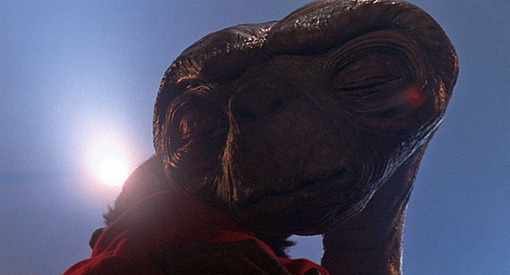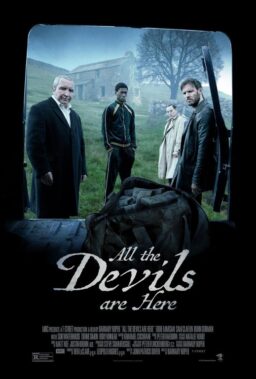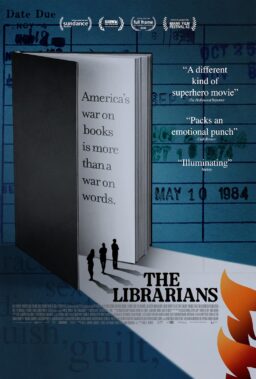[This resurrected piece is my contribution to the Steven Spielberg Blogathon co-hosted by Adam Zanzie (Icebox Movies) and Ryan Kelly (Medfly Quarantine). Originally published in the (pre-home-video) December, 1982, issue of The Informer, a monthly publication of the Seattle Film Society, when I was just a wee lad, barely a quarter-century old.]
“E.T. The Extra-Terrestrial” is a universal film — and I’m not just talking about the MCA company that released it. Steven Spielberg‘s latest celluloid fable is fast on its way to becoming the most popular movie ever made. Yet, unfortunately, critical attention has been focused primarily on the phenomenon of “E.T.” rather than on the cinematic merits of the movie itself. So much has been said about “E.T.” as an extraordinary entertainment, a masterfully orchestrated work of childlike wish-fulfillment, that people seem to have overlooked the fact that it’s also — dare I say it? — a rich and resonant Work of Art. Perhaps Spielberg is too unassuming, too unabashedly populist in his style and (overt) subject matter to make critics sit up and take notice of what he’s doing from shot to shot.
Nevertheless, “E.T.” is connecting with millions of people worldwide — and for good reason. Like “Close Encounters of the Third Kind,” Spielberg’s other masterpiece about intergalactic harmony and understanding (and perhaps the largest-scale abstract/experimental film released by a major Hollywood studio since Stanley Kubrick‘s “2001: A Space Odyssey.”), “E.T.” is above all about contact, about the very nature of communication, and the system of signs we human beings have created to bring ourselves closer to one another: spoken language, gestures, symbolic objects, physical contact — and any combination of the above.
The ad slogan for “Close Encounters” (hereafter referred to as “CE3K”) was “We Are Not Alone,” and both that film and “E.T.” are about alienated individuals who try to break out of their isolation, who struggle to bridge the void between themselves and others. Perhaps the best way to get to the heart of these movies is to take a look at some of the ways Spielberg’s characters communicate with (or fail to reach) each other — and how Spielberg uses cinematic technique to bring film, characters, and audiences, into contact.
Odd Men Out. “CE3K”‘s Roy Neary (Richard Dreyfuss) and “E.T.”‘s Elliott (Henry Thomas) are Alone in some crucial way at the beginning of their respective film-stories. Spielberg’s movies are often about fractured families (remember Goldie Hawn‘s and William Atherton‘s attempt to reconstitute their family unit in “The Sugarland Express,” and Roy Scheider‘s concern with keeping his family intact, especially his two boys, in “Jaws“).

Roy is a dreamer, a kid at heart (we first see him with his son, playing with a model railroad set), who wants to share with his own kids the profound imaginative excitement he himself experienced upon seeing Disney’s “Pinocchio” as a child. (There’s also the suggestion that he’d like to recapture his own childhood through his children.) But Roy’s kids aren’t interested in “Pinocchio” — they’d rather crash trains or play goofy golf. (This scene, excised from the original 1977 version of “CE3K” has been reinstated in the 1980 “Special Edition.”) Later, at home on the same table on which he’s set up the model railroad and his mystery mountain model), Roy uncovers a “Pinocchio” music box that has been buried under some newspapers. The box tinkles out “When You Wish Upon a Star,” a musical theme that will reach its apotheosis in John Williams‘ scoring of the film’s final scene.
Elliott is introduced as he tries, and fails, to join in a game of Dungeons and Dragons that his older brother Michael (Robert MacNaughton) and cronies Steve, Greg and Tyler (Sean Frye, K.C. Martel, Tom Howell) are playing. The older boys form a circle around the kitchen table; Elliott stands outside this circle of friends and exclaims, “I’m ready to play now you guys.” But to no avail: “We’re in the middle now, Elliott,” one of the boys says exasperatedly. “You can’t just join any universe in the middle.” They try to get rid of Elliott, the pesky younger brother, by sending him out to pick up a pizza.
Roy’s encounter with the aliens costs him his job and estranges him from his family. Elliott’s first encounter with E.T. makes him the subject of ridicule from the other boys, and then from members of his own household. Pouting at the dinner table because no one believes him, Elliott widens the riff between himself and his family when he lets it slip that his father is in Mexico with a new girlfriend. Elliott’s mother Mary (Dee Wallace) leaves the table in tears and Michael scolds him: “Dammit, why don’t you grow up — think about how someone else feels for a change.” Elliott takes his dishes to the sink to wash them out and, through the rising steam, gazes longingly at the sky. The time is right for both Roy and Elliott to [re-]discover the meaning of “family” (and “empathy”). Roy finds a whole new family with Jillian Guiler and her son Barry (Melinda Dillon and Cary Guffey) — and, finally, with the aliens themselves. Elliott renews and strengthens the bonds within his own family through his contact with E.T.

Symbols and Models. Man is the only creature on this earth who feels the need to justify his existence, to give meaning to his own life, through the use of symbols. Whether the significant object is a crucifix or Stonehenge, a painting, a sculpture, a piece of writing (“meaning” coded into clusters of graphic symbols), or a film, humankind craves Meaning in the form of physical objects that represent/embody ideas and testify to the individual’s, and the species’, significance. In “CE3K,” Roy’s initial alien contact leaves him obsessed with an idea — or, at least, an image. Problem is, he’s not quite sure of the nature of the idea. In his eyes, the whole world is suddenly, miraculously transformed. A lump of shaving cream, a pillow, a pile of mashed potatoes, a child’s mud castle — all become significant objects charged with deep, subconscious meaning, suggestions of a new life beyond the ordinary.

The shape becomes Roy’s equivalent of the Holy Grail. “I know this!” he cries. “This is important. This means something!” Roy Neary, electrical lineman, metamorphoses into a mad artist (perhaps, as we will see later, a kind of surrealist) — transforming everyday objects and raw materials (clay, wire fencing, foliage, a plastic garbage can) into meaningfully mysterious shape. In his suburban basement, he builds an idol in the shape of… the shape. What is this shape? It’s Devil’s Tower in Wyoming: the Goal, the MacGuffin, Roy Neary’s ticket to heaven. The link between Roy and the alien consciousness is imbedded in his mind; he must solve the puzzle he himself has become.

The Devil’s Tower shape in “CE3K” is a symbolic pointer to a physical location where human-alien contact is set to take place. Elliott, trying to give E.T. his bearings, uses other symbols: an atlas, a globe, and a map of the solar system. At first the effort seems ridiculous: how is this little squashy guy going to make the connection between these man-made miniature representations and actual physical/geographical/interplanetary space? “We are here,” Elliott says, pointing to some little dot in a space on a map artificially labeled “California.” “Earth… home… home… home. Where is your home?” E.T. points out the bedroom window toward his home — in relation to the globe, and in relation to the earth itself from where he is standing. Does he really understand the concept of the model? Yes, he does. Using a map and some colored balls, E.T. puts together a working model of our solar system. An intelligent being capable of higher abstract/symbolic thought, E.T. cuts through the language barrier here and communicates directly through tangible, mutually understood symbols.

Elliott uses other models, objects that exist only in reference to other objects, to introduce his world to E.T. While Roy builds models to externalize what has been imprinted on his mind, in hopes that these physical objects will help him understand what the aliens are trying to tell him, Elliott uses the models in his room to (absurdly, hilariously) explain the fundamentals of human culture to E.T. He picks up a can of Coke with an artificial plastic spill (“See, we drink it. It’s a drink. You know… food.”). He follows with: some little plastic men and space creatures (“And look, they can even have wars. Th-th-th-th-th-th. Uuuuuuuuuuugh.”); a goldfish in a bowl and a plastic shark’s head on a stick (“The fish eat the fish food and the shark eats the fish. Nobody eats the shark.”); a Pez dispenser with candy that pops out of its plastic head; a peanut-shaped coin bank (“This is a peanut. You can’t eat this one ’cause it’s fake.”); money (“We put the money in the peanut” — one can’t eat the peanut, but the peanut can eat the money); and a miniature car (“This is what we get around in.”) The scene is funny (and not just the “Jaws” gag) because it’s so simple — and yet how would an alien, even if he is of higher intelligence, going to deduce anything about our world from these toys?
Well, whether it is conscious or not, Elliott does eave an underlying theme into his introductory presentation: most of the objects represent food. E.T. may not pick up on all of Elliott’s logic, but he evidently catches the subtextual drift: he tries to eat the car — practically the only item that couldn’t be eaten even if it was “real.” “No, you don’t eat it,” Elliott admonishes. Then he pauses, as if reminded of something. “Are you hungry? I’m hungry.” Communication has occurred — somehow. This is an early indication of the telepathic empathy between Elliott and E.T. (whose Earth names are also symbolically intertwined: ElliotT).

Surreal Connections. Flashback: Luis Bunuel‘s and Salvador Dali’s “Un Chien Andalou,” 1928. A man with a razor (Bunuel himself) steps out onto a balcony and looks to the heavens. CUT: A long, thin cloud moves toward the full moon. CUT: The round face of a young woman fills the frame. The barber holds her eye open with his fingers and moves his blade into position. CUT: The cloud slices across the moon. CUT: A hand glides a straight razor as it slices through an eyeball.
Like Bunuel here, Spielberg is a master of the purely visual connection (and not just match cutting), a powerful, somewhat surreal technique that goes beyond rational, linear language [or “symbolism”] into the rarefied realm of what Hitchcock liked to call “pure cinema.” I’ve already mentioned the shape from “CE3K,” which carries with it a palpable sense of the Ineffable, the Suggestion Of An Understanding Beyond The Ordinary — like Bunuel/Dali’s striped box in “Un Chien Andalou” (not to mention the buzzing black one in Bunuel’s “Belle de Jour“), or one of Dali’s painted crutches or melting timepieces. The shape becomes Roy’s fetish, and no one has a purer cinematic appreciation for fetishes than Bunuel.

The surrealistic “Un Chien Andalou” creates “impossible” connections through montage. At one point a series of match dissolves takes us from an ant-hole in the palm of a man’s hand to a woman’s armpit to a sea urchin to an iris shot of the top of another woman’s head. (Also, she’s poking a severed hand with a stick.) These images have no relationship to each other in real/linear time or space, but they are similar in shape (round) and they occupy the same general area of the frame as one dissolves into another. One of the tenets of Surrealism was that it sought to express “the true process of thought” by communicating directly from the subconscious mind of the artist to the subconscious mind of the viewer with minimal filtering through rational thought processes. [That’s the desired effect on the viewer, although the artist obviously had to consciously shoot and cut these images together.] In “E.T.,” Spielberg uses montage to put us inside the joined subconscious minds of E.T. and Elliott. Their telepathic link is never explained — we simply experience it along with them.


Spielberg creates this “impossible” cause-and-effect relationship between E.T.’s and Elliott’s actions as E.T. explores the kitchen at home [in the Southwestern suburbs, that is] and Elliott simultaneously attends school miles away. That is, the relationship would be impossible if we did not see it before our eyes. The logic of the montage leads us to one inescapable conclusion: Elliott and E.T. are, somehow, one. If E.T. initiates an action, Elliott completes it. E.T. drinks a can of [not fake] Coors; Elliott burps. E.T. bumps into a kitchen counter; Elliott reacts, frowns. E.T. hits his head again; Elliott sinks in his chair. E.T. falls on his face; Elliott falls under his desk. While Elliott’s teacher attempts to guide his students through a frog dissection, E.T. plays with a Speak ‘n’ Spell learning toy. E.T. goes from punching buttons on the Speak ‘n’ Spell to punching buttons on the TV remote control. The TV comes on; a cartoon cat squeals because his tail is on fire; E.T.’s face lights up in alarm, his neck elongates, and the throws his beer can at the TV. Elliott’s teacher puts etherized cotton balls in the students’ frog jars.

Elliott, resting his head on a desk, looks at his frog. The frog looks kinda like E.T. “Say hi,” Elliott coaxes. “Can you talk? Can you say hi?” (Elliott’s first words to E.T. are, “Can you talk?” — and by the time the boy gets home from school, E.T. will have learned to speak English, thanks to TV, “Sesame Street,” and Gertie.) E.T. burps, raises his head off the counter and looks at a “Buck Rogers” comic strip. The last panel features a dish antenna sending out radio signals. We hear a voice on the TV: “Hello, Uncle Ralph.” E.T. looks at the screen, where a person is speaking into a telephone (a Bell System commercial). Pan from the TV to a phone on a nearby table. A kid on TV hangs up the phone. Cut to a close-up of the living room phone, and back to E.T.’s face. Match cut to Elliott’s face. “Save him,” Elliott says. He is moved to set all the frogs loose: “Back to the forest!” (where we have first encountered E.T.). Playing with the Speak ‘n’ Spell, E.T. hears a howl on the television. He looks up to see John Wayne and Maureen O’Hara in John Ford‘s “The Quiet Man.” Waynes and O’Hara’s movements on TV are intercut with matching movements by Elliott and the pretty blonde girl who obviously has a crush on him (blonde in Southern California being the equivalent of redhead in Ireland). The lovers — in the movie on TV and in the classroom — kiss. E.T. smiles. The soundtrack music swells. Victor Young’s “Quiet Man” music (in Dolby Stereo, suddenly) becomes the score for the setting-free of the frogs.
I’ve tried to quote from this sequence in detail (though this account contains several ellipses) to demonstrate how each shot flows into the next, introducing a new element, a new, free, association, which bridges the shots on either side of it. Moment-by-moment, new syntheses are being created. E.T. and Elliott, television and reality, flow in and out of each other. (E.T. must understand the principles of editing as well: the two ends of the telephone phone conversation are depicted in separate, juxtaposed shots — montage within montage!) In this sequence, Spielberg communicates an inspired, harmonic wholeness — a sense of human beings and aliens, life and art, working in concert.
Family: Elliott, E.T. and Keys. Andrew Sarris has complained that Spielberg cheats the ending of “E.T.” by photographing Keys (the scientist/searcher played by Peter Coyote) and Mary together in a two-shot as if they were a couple. Sarris points out that the two have just met and there is no justification in the plot for treating them as a pair. (He neglects to mention that the shot is really of Mary, with Keys out of focus behind her.) Sarris accuses Spielberg of fudging to create an artificial sense of completeness in the film’s operatic final moments. But from the very beginning, Spielberg has been preparing us for such a payoff. Elliott’s real father is never seen, but the movie creates visual connections between Elliott and Keys — through E.T. — so that, by the end, E.T.’s visit has, symbolically at least, made it possible for Elliott’s family circle to be complete again.
Keys, who is initially seen only from hip level, from the height of an Elliott or an E.T., is also searching for E.T. His search and Elliott’s are played off each other. When Elliott goes out spreading Reese’s Pieces candies (in much the same way that Hansel and Gretel left a trail of bread crumbs so they could find their way back home), he comes upon Keys looking for E.T. in the same area of the woods. E.T., meanwhile, hides behind a nearby tree. The three are linked simply by being in the same place at the same time.

At first, Keys is seen as a threatening presence, but Spielberg indicates early on that Elliott, E.T. and Keys are essentially all on the same side. After Elliott has lured E.T. into his room with the candies, the tension and anxiety between them begins to dissipate and they relax with each other. E.T. purrs and Elliott drifts off to sleep. Cut to Keys, discovering a nest of colored, egg-like objects in a clump of ferns. We know they’re Reese’s Pieces, but we can also imagine them as alien eggs. Keys reaches down carefully, gently, picks up one of the “eggs” with his thumb and index finger (just as E.T. does) and lifts it out of the frame to examine it more closely. A crunching, chewing sound comes from off-screen. Like a kid, or an extraterrestrial, Keys eats the candy. Elliott put the treats out in the first place because, well, he likes candy, so that other little guy must, as well. Keys, too, follows Elliott’s “trail of crumbs.”
It is Keys whom we follow into Elliott’s house once the scientists have turned it into a cocoon (from which, of course, E.T. will be reborn). Keys’ two fingers (like E.T. again) tap on Elliott’s oxygen tent. Of all the doctors and technicians present, only Keys actually talks to Elliott. “He came to me,” Elliott says. “He came to me, too,” Keys explains. “I’ve been waiting for this since I was ten years old… You did the best anyone could do. I’m glad he met you first.” The child is father to the man: Keys is an adult version of Elliott, the man he could become; Elliott is the child Keys once was — and, in spirit, at least, still is.

Keys and Mary are the only adults privileged to witness E.T.’s leave-taking. In this scene, as E.T. and Elliott embrace, Spielberg channels some of Elliott’s love for E.T. back to his mother through editorial eye-contact between Elliott and Mary. As Elliott hugs Elliott, his gaze embraces his mother. With all the film’s most important characters gathered together here, it’s appropriate that they be seen as a complete family unit. E.T. has brought them all together in this hallowed place. After all that has transpired, Keys takes his rightful place beside Mary as Elliott’s stand-in, the lead male in the family, even though he’s the middle child. (Interpret Oedipal resonances as you like.) As the spaceship paints a rainbow in the sky, the characters are grouped in a series of close-ups: Mary and Keys (the adults); Steve, Greg and Tyler (the friends); Michael and Gertie (the siblings). Cut back to E.T.’s rainbow, symbol of his promise to remain “right here” in Elliott’s mind and memory, and, finally, a heroic low-angle slow zoom in on a suddenly much older- and wiser-looking Elliott.


Greetings. In “CE3K,” a five-tone musical figure is the aliens’ greeting to humankind. It doesn’t “mean” anything in and of itself (though, electronically transmitted, it can be decoded as the longitude and latitude of the aliens’ landing site). But this musical theme, no matter what form it takes, runs through the film as a motif that signifies understanding and sympathy between humans and extraterrestrials. The scientists who first pick it up immediately begin sending the same message back again as a return greeting. The Indians adopt it as a chant. Little Carry Guffey plays the tune on his toy xylophone shortly before he allows himself to be adducted. Lacombe (Francois Truffaut) uses Zoltan Kodaly’s system to translate the tones into hand signals. At the landing site, a display board is constructed to turn the notes into colored light. The first “official” communication between the humans and the aliens comes when the technicians play the tones and the mothership repeats it back to them — so loud it shatters glass. One party extends a greeting, the other party returns it: contact.
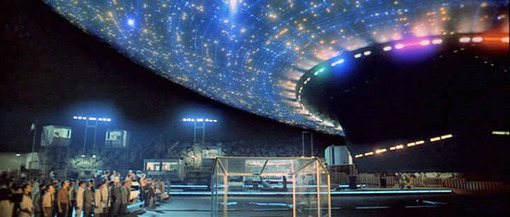
Elliott hears a noise in his shed. He tosses his baseball in. Somebody tosses it back out. The boys inside the house won’t let him into their game, but at least this creature — whoever or whatever he is — will play ball. Elliott leaves a trail of candies; E.T. returns a handful as an offering of friendship. The first time these two meet face to face, they don’t exactly greet each other — they cry out in shock. Yet Spielberg, by cutting between their frightened faces, emphasizes that they are mirroring each other’s fear. One is just as scared as the other.

Gertie (Drew Barrymore) screams the first time she meets E.T., too. By now, this custom appears to be old hat for E.T. He raises his neck, puts up his hands and returns her scream, as if to say, “OK, if this is the customary way we introduce ourselves here, I have learned my manners.” The funniest moment in the film, for me, is when Gertie steps into the closet, turns to stare at E.T. (offscreen), opens her mouth and lets loose another shriek. Michael puts his hand over her mouth and drags her out of the frame, screen left, while from screen right a squealing E.T. glides into view to complete and return her greeting. He actually seems to be enjoying this. What a funny way to say “hi.”
Evolving language. Kids are always picking up new words and phrases, and trying them out in different situations. That’s how they learn new ways to more accurately say what they want to say. In “E.T.,” bits of language accrete meaning as they are picked up and repeated/transformed by various characters. Steve mockingly calls the mysterious creature Elliot says he has found an “extraterrestrial.” (Steve is also trying to show off his own vocabulary — despite his superior tone, he stumbles over the word.) Later the same day, Elliott draws a picture of the little squishy fellow and, abbreviating the word he’s heard from Steve, labels his portrait “E.T.” — an elision of Elliott’s own name.

Elliott takes the phrase “absolute power” that he’s heard applied to the Game Master in the Dungeons and Dragons game from which he was excluded, and forces Michael to bestow the term on him (“You have absolute power”) before revealing E.T. Elliott isn’t just trying to get Michael to admit that his younger brother is in the superior position (the person who holds the secret is always in the superior position), but he wants Michael to use the same language with him that he uses with the older boys. One indication of how Elliott has grown in Michaels eyes is that Michael later picks up Elliott’s term “most excellent promise” and uses it with Marie.

Gertie, the youngest in the family, has a habit of repeating her elder brothers’ language as a way of learning, and showing she can talk like a big kid: “… rats in the sewers”; “… a deformed kid.” It’s Gertie, while repeating words back to the TV as she watches “Sesame Street,” who inadvertently teaches E.T. to talk. E.T. is behind the television, and when he hears Gertie say “B,” he lifts his head over the set, repeats “B” (another greeting?), and retracts his neck again. “‘B!” you said ‘B’! Good!” Gertie exclaims in astonishment. E.T. repeats her last two words (just as Gertie did with Michael at dinner) as “B good.” These are E.T.’s last words to Gertie. He tells her to “Be good.” He may be unaware of the semantic meaning of the phrase, but it’s enough that he associates the sounds with Gertie. She tearfully tells E.T. goodbye, but Michael assumes E.T. doesn’t know the word, since no one has used it with him before. But, of course, Michael is pointing ahead to the film’s last words (a goodbye that’s not a goodbye), and E.T.’s ability to maintain connections across physical space.
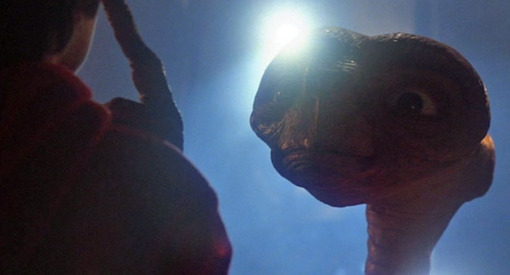
Reach Out and Touch Someone. Spielberg’s (and “E.T.” screenwriter Melissa Mathison‘s) characters use every conceivable means to make contact: gestures, symbols, telepathy, spoken language, written language (Elliott and Michael leave Mary a note to inform her of E.T.’s resurrection and their plan to get him back home). But perhaps the closest encounter of all is actual physical contact. As Michael gently strokes E.T.’s cheek in a farewell caress, the alien exhales a delicate, almost orgasmic sigh, full of sorrow, gratitude and yearning. In “E.T.,” the act of touching often carries with it the miraculous power to heal. In the film’s final scene, gesture, language and touch are fused: E.T.’s healing gesture (a glowing fingertip, applied to Elliott’s wounded digit and to Michael’s trick knife-in-the-head — like the peanut, the latter is fake) becomes associated with Elliott’s exclamation, “Ouch!” E.T. expresses his pain at having to leave Elliott by tapping his chest, motioning toward Elliott, and saying, “Ouch.” Elliott repeats the movement and the word. Finally, E.T., echoing Elliott’s earlier promises (as he left E.T. in his bedroom, and as they both lay dying), combines his healing gesture with the words, “I’ll be right here.” E.T. touches his own lips, and then, with that glowing fingertip, touches Elliott’s forehead. Though lightyears of space and time may henceforth separate Elliott and E.T., each will continue to live in the other’s mind, the other’s dreams.
 (The final shot of “E.T. — The Extra-Terrestrial.” Elliott grows up before our eyes.)
(The final shot of “E.T. — The Extra-Terrestrial.” Elliott grows up before our eyes.)
(Ammended, corrected and slightly expanded in December, 2010, from the version published 28 years before.)

